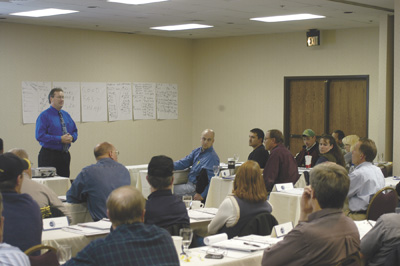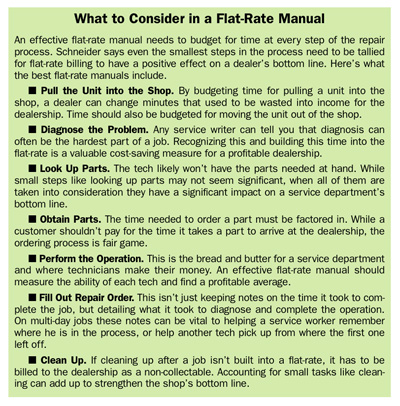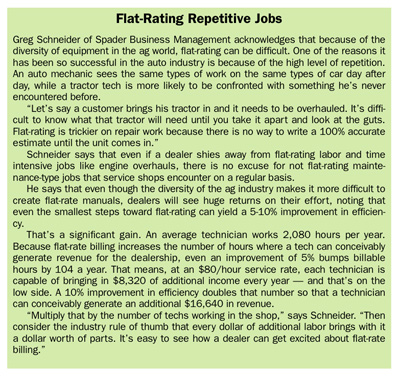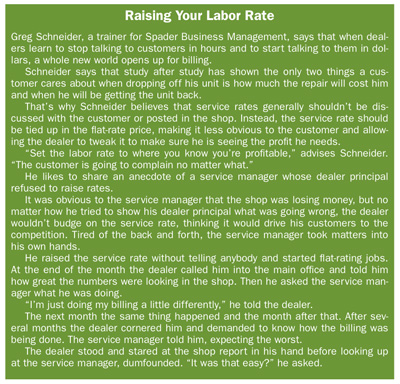When done correctly, flat-rate billing can significantly improve the efficiency of your service department and increase the income your techs are bringing in by thousands of dollars each.
Flat-rate billing is the keystone for any service department wishing to run at peak efficiency, says Greg Schneider, a trainer for Spader Business Management. That's because an effective flat-rate system increases the possible number of hours that a service department can collect on. In a flat-rate system, instead of being charged by the hour, a customer is presented with a set price for the job requested.
While incorporating an entirely new billing system in a shop may seem daunting, Schneider says that most dealers are closer than they think. "Truth be known, everybody is doing some type of flat-rating already," he says. "Say a customer comes into your dealership because a tree fell on his tractor. He wants you to give him an estimate for the insurance company and you huddle with your techs to discuss what kind of work will need to be done to fix it. The number that you come back with is essentially a flat-rate price for that job."
The service rate doesn't disappear, says Schneider, but gets folded inside of the estimate right along with parts, prep time and any miscellaneous costs that a dealer suspects might come up in the job.
A successful flat-rate billing system operates on the law of averages. A dealer needs to take into consideration how long the job will take each of his technicians, and then arrive at the average amount of time that a certain job will take in his service department.
Some of the techs will be able to beat the flat-rate time, but others will fall short. The more effective a service department is at flat-rate billing, the more profitable it will be for the dealership and the techs, and the happier the customers will be.
Why Flat-Rate?
As the effectiveness of the flat-rate system increases, the efficiency of the service shop increases, says Schneider. A flat-rate is based on how long a job is estimated to take, but a technician has the opportunity to beat that time.
If a job is flat-rated to take 2 hours, and a speedy tech is able to finish it in 1 hour, the technician is running at 200% efficiency. Because he was able to finish 2 hours of work in 1 hour, all of the costs built in to the flat-rate are collected in only half the time. The tech frees up his extra hour for other flat-rate jobs and essentially bumps what was an $80/hour shop rate up to a $160/hour.

Greg Schneider, a trainer for Spader Business Management, listens as dealers and technicians talk about their experiences with flat-rate billing. Schneider says that a good flat-rate system can improve a shop's efficiency by over 10%.
That kind of efficiency isn't possible in an hourly-rate based system. In fact, without flat-rate billing, the highest efficiency a technician can achieve is 100%, but even that is unrealistic.
Schneider says that the most common rebuttal to flat-rate billing he encounters is the false belief that as soon as a service shop starts flat-rating jobs, quality takes a dive.
The idea is that a tech who is only interested in making his numbers look good and beating the flat-rate is more likely to take shortcuts than a technician who doesn't have incentive to do the job quickly. The service worker who works faster, people believe, is more likely to make mistakes, so the level of "bring backs" will be much higher in a shop that flat-rates, and all of the efficiency that was gained will be lost figuring out what went wrong.
For this Schneider says the solution is simple: just take away a tech's incentive to rush orders out the door. There are many ways to provide incentives for quality as well as quantity in service, including tactics that affect any bonuses or other incentives offered by the dealership for high-performance.

A tech should still have incentive to finish the job quickly, Schneider says, but also to the best of his ability. If a piece of equipment is "brought back" on him, the time it takes to fix the unit properly should be documented and counted against his efficiency standing.
This avoids any impulse a service worker might feel to speed through a job to strengthen his numbers.
Instituting a flat-rate billing system in the service department also allows dealers a clear line of sight to compare workers against one another. It raises a baseline that each can be measured against, so a problem with an individual worker becomes quickly apparent.
Building a Manual
Before a flat-rate billing system is incorporated, a dealership will need a flat-rate manual to price from. These are common in the auto industry, but Schneider has found that many ag manufacturers don't have anything available that offers a healthy retail flat-rate.
Schneider cautions that a retail flat-rate is different than a warranty flat-rate, where estimated times can be based on "laboratory conditions." When determining a warranty flat rate, manufacturers may present a piece of equipment to an experienced technician and tell him exactly what's wrong with it. He has all the tools and parts he will need on hand. When the tech is ready, someone with a stopwatch says "go" and he gets to work.
"It isn't a totally accurate study of what it takes to fix a piece of equipment," says Schneider. "When the work is finished, the time is recorded. It might take him 6 minutes to replace a common part, so the warranty manual flat-rates 1/10 of an hour. In most shops that I've been in, you can't even pull a unit into the shop in 1/10 of an hour."
In reality, Schneider says that in order to increase efficiency, a dealer needs to take more into consideration than what many warranty guidelines provide. He says that an effective flat-rate manual needs to account for everything from pulling the unit into the shop to the time it takes to fill out a repair order and clean up.

Unfortunately, this guide doesn't exist. Even if it did, it wouldn't account for the strengths or weaknesses of any particular service shop, or the abilities of a specific shop's technicians. The solution, Schneider says, is to make your own.
For a dealer, the thought of implementing flat-rate billing is scary enough without the added worry of developing his own manual. Still, Schneider says that creating your own flat-rate guide is the only way to see optimal results.
The best way to start is to gather all of a shop's technicians on a Friday afternoon and present them with a list of 10 common jobs. Tell them that their homework for the weekend is to think about what it takes to finish each one of those jobs, keeping in mind all of the "extras" required to determine an effective flat-rate (see "What to Consider in a Flat-Rate Manual" on page 20).
When they return to work on Monday morning, collect the lists and tally up their estimates. Schneider warns that their answers may vary greatly based on experience or skill, but says that flat-rating works by beating the averages.
Every week, the staff in the service department should be presented with a list of 10 new jobs and given the same homework assignment. "Over the period of 6 months to a year, the dealer will have established a pretty substantial flat-rate manual."
At least he'll have established a pretty substantial beginner flat-rate manual. Schneider says that while the flat-rates are being determined, the time it takes to finish each job should be constantly re-evaluated based on the time tickets of the technicians. He notes that often a tech may think he can finish a job faster than he actually can, or that he may become more efficient and start finishing jobs in less time.
He suggests that service slips be revisited every quarter and that flat-rate times be recalculated to include the new data. As more data is acquired, the flat-rate times will get tighter and tighter, says Schneider, and eventually they will get to the point where they're difficult to budge. That's when you know you're at a solid number.







Post a comment
Report Abusive Comment